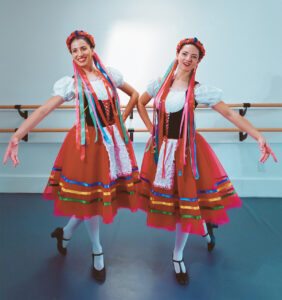A Ballet in Three Acts
June 3-4 | Destin Community Center | Tickets: studio6twenty5.com
Director: Rachel Prescott | Assistant Director: Shaye Smith
“Just as Giselle is ballet’s great tragedy, so Coppélia is its great comedy.”
– George Balanchine on the importance of Coppélia
Our story takes place in a small village of Galicia, a province of Austria-Hungary, with today’s map finding Galicia in western Ukraine and southeastern Poland. The “color” of the region can be seen in the brilliant colors, heavy embroidery and elaborate trimmings of the costumes. It can also be heard in the rich nationalistic melodies and complex folk dances of the composer. This was the first use of the Hungarian czardas to be performed in a ballet, which is a very complex national dance; both the czardas and mazurka dances in Coppélia were the culmination of the region’s folk dances.
At the age of 33, Delibes was commissioned by the Paris Opera to write his two, large-scale ballets, Coppélia and Sylvia. Coppélia is based on a story by E. T. A. Hoffmann – the same tale that sparked Offenbach’s brilliant “Doll Act” in his opera, The Tales of Hoffmann.
Premiering on May 25, 1870, at the Theatre Imperial de l’Opera in Paris, this story is a delightful tale of fantasy with a happily-ever-after ending for Swanhilda, a young village girl who becomes fascinated by the eccentric Dr. Coppelius and his unresponsive “daughter,” Coppélia.
Studio6twenty5’s productions of Coppélia feature more than 50 students in our Children’s Program, ages 2-8. Our Adult/Open Program dancers are also featured throughout the ballet.
Tickets can be purchased online at studio6twenty5.com.
Act I
A village Square in Galicia
The curtain rises on the village and a lovely young girl, Coppélia, is seen sitting on a balcony reading a book as Swanilda enters. Swanilda looks up at the girl, tries to attract her attention, but receives no reply.
The villagers are preparing for the Harvest Festival. The official party, led by the Town Bürgermeister. The celebration is momentarily interrupted by Dr. Coppelius, whose mysterious “daughter” causes a quarrel of confusion. The villagers disperse to await the Harvest Festival the following morning, where the Hours of the Day are to be celebrated. Meanwhile, Swanilda and her friends sneak away to investigate the strange house of Dr. Coppélius.
Act II
Inside Dr. Coppelius’ house and workshop – that evening
The curtain rises on the dimly-lit interior of Dr. Coppélius’ shop — a room full of life-like, life-size dolls. One of Swanilda’s Friends pokes her head behind a curtain to discover Coppélia. Another friend finds Japanese Dolls, another finds French Dolls and an Arabian Doll, while other friends find Spanish and Scottish Dolls, all of whom dance until its clockwork runs down. The amazed young intruders then wind up all the dolls again, who dance as the friends watch, enchanted. Suddenly, a furious Dr. Coppélius enters and all of the culprits flee, except for Swanilda and one of her friends, who runs into the alcove where Coppélia is kept. Coppelius is fooled by Swanilda and thinks his mechanical doll has come to life. When Swanhilda reveals she has changed places with the doll, Dr. Coppelius is left broken-hearted.
Act III
Outside the church – the next morning
The day of the celebration has arrived. The gathered villagers begin to celebrate the Harvest Festival. Dr. Coppélius storms in, accusing Swanhilda of destroying his life’s work. Realizing the justness of his claim, she offers him money, but instead the Bürgermeister gives Dr. Coppélius a bag of gold and sends him off. The Harvest Festival continues as the villagers celebrate the hours of the day. The townspeople dance into the night.
The post studio6twenty5 proudly presents Coppélia June 3-4 appeared first on South Walton Life | 30A News, Events and Community Information.


Be the first to comment on "studio6twenty5 proudly presents Coppélia June 3-4"